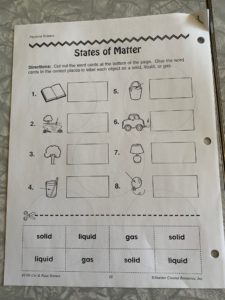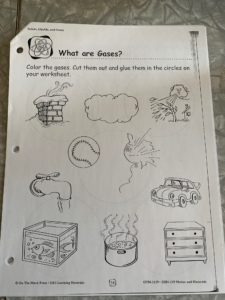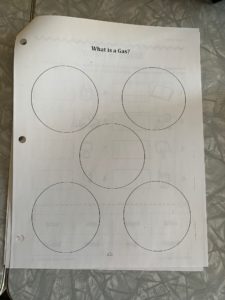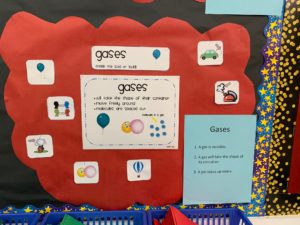Science
My learning goals for Science in the month of June is to finish up our Unit on Light.
Week 11: Learning at Home Menu
Lesson 1: Rainbow
- This is a great time to talk about God creating the rainbow and why he did.
- Then move into the scientific explaination of us seeing a rainbow when sunlight is reflected through a raindrop
- You can print the page below or create a Journal write with it.
Lesson 2: prisms
- What is a prism? What does it do?
- This is part of our study on light reflecting.
- The page below is directions for a prism experiment.
- If you have a prism, a piece of faceted glass from a lamp, then you can do this experiment
Week 10: Learning at Home Menu – Light
Lesson 1: Light Sources
- Some things produce light and others do not
- Brainstorm a list of things that produce light and those that do not
- You can print out the sheets below and cut and paste, sort and organize the items into light or no light
- If you prefer not to print out the sheets, the students could write a sentence in their Journals and things that create light and then draw and label a few pictures.
Please send me a picture of your light sources
Lesson 2: Light Reflects experiment
- This experiment has to do with light reflecting.
- You can read the instructions in the link below and experiment with a mirror and a flashlight to see where it reflects.
- I also included a secret message that will be reveal when you view through the mirror.
Week 9: Learning at Home Menu – Light
Lesson 1: The sun is our main source of light.
I would like the children to know that the sun is our main source of light and that without it our planet would not survive. God gave us the sun to light our day and the moon to light the night.
- You can print out the paper and have the children print in the word “sun” and then draw a picture of the sun.
- Students can also do this in their Journal if you would prefer not to print.
- Please add the paper to your Science duotang when you are finished.
Please send me a picture!
Lesson 2: Light Travels
- I would like to introduce the words: transparent, translucent and opaque. These are hard words!
- There is an experiment explanation and paper to print off and write on, but if you prefer not to print it you could just have it up on the screen and carry out the experiment.
Week 8: Learning at Home Menu – Science
Lesson 1: Introduction to Light
- What is Light?
- Watch the video
- Have a chat about all the different light sources that you have in your house.
Lesson 2: Shadow Puppets
- find a light source in your house that is safe: flashlight or lamp
- create shadow puppets with your fingers or print out the shadow puppets, colour them, cut them out and then shine the flashlight on them and create their shadow on the wall
- Have a discussion about how we see light from what we learned in the video: the light reflects off of an object and into our eyes telling our brain what we are seeing.
Week 6: Learning at Home Menu – Science
Lesson 1: Make a Joyful Noise
- Many people are garthering on their patios or front steps at 7pm to make a joyful noise to thank our essential workers.
- Have a discussion with your child about why we are thankful for our essential workers during our stay at home time.
- Choose a day at 7pm to get together and make a joyful noise to thank our essential workers.
- Be creative: pots and pans, whistles, anything that makes a noise!
Send me a picture of you making a joyful noise to say thank you!
Lesson 2: Guess that sound
- Listen to the video and try to guess the sounds. How good are your listening skills?
Week 5: Learning at Home Menu – Science
Lesson 1: Sound Safari
- Sit quietly in your living room with your eyes shut. Sit quietly until you hear 5 sounds that you can recognize and tell your mom or dad.
- Go outside and sit quietly in your yard. Close your eyes and listen until you hear 5 sounds that you can recognize and tell your mom or dad.
Lesson 2: Sounds I like and sounds I don’t like
- There are different sounds that are pleasing to the ear : birds chirping, a river rushing, Scout calling
- There are also sounds that hurt our ears or are not pleasant: baby crying, fire alarm, dog barking
- Discuss why we like some sounds and not others
- Please put the finished copy in your Science duotang
- If you pefer not to print, this activity can be done on the interlined paper that I sent home and then put in the Science duotang
Please send me a copy of this .
Week 4: Learning at Home Menu – Science
This week we are beginning our unit on Light and Sound.
Lesson 1: What is sound?
- After you finish watching the video, have a discussion about sound. My goal is that students will understand that sound is vibrations that move through the air and reach our ears and give our brain a message that we are hearing something.
Lesson 2: God- made sounds and Man -made sounds
- There are many sounds that we hear each day.
- Some sounds are God-made sounds or natural sounds: dogs barking, birds chirping, streams gurgling, the wind in the trees, thunder booming, rain pouring down or people talking.
- Some sounds are man-made sounds or artificial sounds: the lawnmower, police sirens, cars honking, the sound of a motorbike, the garbage truck going by your house, or a chainsaw.
- If you want to save on printer ink, this activity can be done on the package of interlined paper that I sent home with the duotangs so long ago.
- Please put your finished sheet into your Socials duotang.
Please send me a copy of this lesson
Week 3: Learn at Home Menu
Lesson 1: States of Matter

- This page is found in the Science duotang
Lesson 2: Matter Experiment
- Water is a very special type of matter that can easily move between all three states.
- Take a glass of water and talk about the properties of a liquid: pours, visible, does not hold it’s shape, has weight.
- Put the glass of water in the freezer. When the water is frozen talk about how it turned into a solid by decreasing it’s temperature (taking away heat). Talk about the properties of a solid: holds it’s shape, visible, hard, does not pour
- Pour a glass of water into the kettle and boil it. show the students the steam coming out of the kettle and talk about the properties of a gas: invisible, does not hold it’s shape, takes up space. Discuss that it was adding heat that changed the water from a liquid to a gas.
- My goal is that the kids understand that some forms of matter can change forms by adding or taking away heat.
Week 2: Learn at Home Menu
Lesson 1: How many gases can you find?
- In the Science duotang, you will find a page called “What are Gases?”

- Students will find the gases: smoke, wind, air, steam and car exhaust (difficult to figure out that one)
- They will colour the pictures of gases and cut them out.
- Students will then glue the pictures of the gases into the circles on the next page in the Science duotang.

Lesson 2: Is a Fart really a gas?
- Watch the youtube video
- Have a fun discussion on the topic of farts being a gas. I know the kids will enjoy this one!
Week 1: Learn at Home Menu
1. Matter Chatter: Using our Science duotang find the sections on Solids and Liquids that we have already covered and have a conversation with your child to review as you go through the completed pages in the duotang (near the back).
- What are 5 examples of a solid that you can find in your home? ex: couch, tv, fridge, toys, walls
- What are the rules of a solid that we have already learned? ex: takes up space, has weight, visible, holds a shape
- What are 5 examples of a liquid that you could find in your home? ex: water, juice, milk, honey, dish soap
- What are the rules of a liquid that we have learned in class? takes up space, has weight, visible, pours, changes its shape to fit the container.
2. What is a Gas?

- Brainstorm with your child as many gases as you can think of. We have already talked about: wind, smoke, steam, farts, oxygen, helium, car exhaust.
- Talk to your child about the rules of a gas: takes up space, spreads out to fill the container, invisible
- At the back of the duotang are a few pages on gases. Fill in the page titled: Properties of a gas
Please send me a picture of your completed “Properties of a Gas” page.